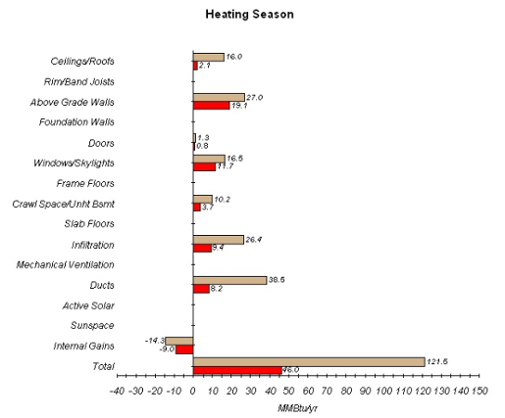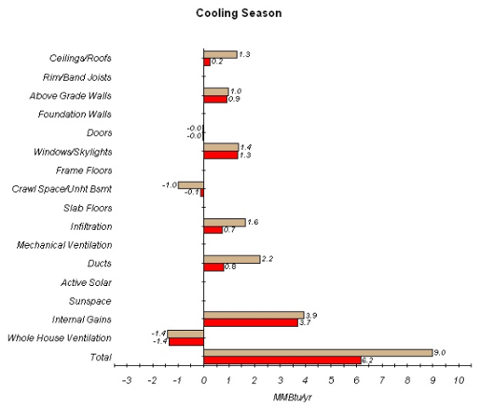An Energy Efficient Mortgage (EEM) Bonanza

As a HERS (Home Energy Rating System) Provider, I check the home energy ratings that my raters do. Recently one of the EVER raters, Jason Payne of Structured Energies, completed a rating project for a homeowner who was financing home energy efficiency improvements with an Energy Efficient Mortgage (EEM),* and the results are stunning. Really!
As a HERS (Home Energy Rating System) Provider, I check the home energy ratings that my raters do. Recently one of the EVER raters, Jason Payne of Structured Energies, completed a rating project for a homeowner who was financing home energy efficiency improvements with an Energy Efficient Mortgage (EEM),* and the results are stunning. Really!
Below you see a graph of the energy consumption for heating. The total amount of energy required to heat this house before improvements was 121.5 million Btu per year. After improvements, it was 46 million Btu per year. That’s a reduction of over 60%!
This house is in Atlanta, where we use more energy for heating than cooling (I’m not kidding!), so the cooling reduction wasn’t as great. Still, cutting the energy used for cooling by a third is nothing to sneeze at.

I’m going to write up a case study for this project to detail the home energy efficiency improvements made, complete with photos and specs, but you can get an idea of what was done from the graphs above. Like most homes, this one had too much infiltration and too much duct leakage, so they did a lot of air & duct sealing. Then they made insulation improvements to the building envelope to minimize the heat loss and heat gain. Finally, they replaced the ancient furnace (68% efficient) with a new, sealed combustion, high efficiency (95%) furnace.
In terms of the energy bills paid by the homeowners, the energy modeling showed that they’ll save over $1100 per year, or nearly $100 per month. When I write up the case study, I’ll include the costs of the improvements (which I don’t know right now) and show how making these improvements probably has had an immediate payback. In this case, the homeowner was also able to take advantage of generous energy efficiency rebates from Georgia Power an the home energy efficiency tax credit.
If you think a house this inefficient is uncommon, think again. Most existing homes are ripe for savings like this, and financing them with an Energy Efficient Mortgage, as I’ve said before, is a no-brainer.
[*Sometimes the term Energy Improvement Mortgage (EIM) is used to describe an Energy Efficient Mortgage used for improvements on an existing home. FHA, however, calls them both two different types of the EEM.]This Post Has One Comment
Comments are closed.

If you like this article,
If you like this article, please consider sharing via one (or more) of the buttons at the top. Thanks!